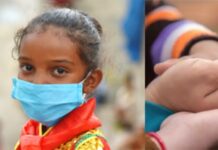[vc_row][vc_column][vc_column_text]
The first one thousand days of a child’s life determine his/her future. So runs a 2020 television advertisement featuring one of India’s top cine stars Amitabh Bachchan dressed in elegant Indian sartorial sherwani and trousers. In sharp contrast with the glitzy ad, the condition of the child and the mother who brings the child into the world is far from reassuring. It is a tale of humongous malnutrition – massive stunting (too short), wasting (too thin) and obesity – for the years of children’s age.
In 2017, a staggering 68 per cent of 1.4 million (14 lakh) deaths of children under five years in India was attributed to malnutrition, according to Arjan de Wagt, chief representative, Nutrition, UNICEF, India, also quoted in the British journal Lancet. Another shock finding by the World Health Organisation (WHO) reveals that three out of ten stunted children in the world belong to India.
“About half of all children under five years in the country (India) were found to be stunted (too short) or wasted (too thin) for their height,” according to the National Nutrition Survey, carried out three years ago by the Indian Ministry of Health and Family Welfare.
Worsening levels of malnutrition and obesity came as a startling revelation in a mid-December 2020 report of the Fifth National Family Health Survey released by the Ministry of Health and Family Welfare. The survey covered 22 states and Union Territories in the first phase before the onset of Covid-19 global pandemic, with the second phase report expected in May 2021. Added to the triple burden – of stunting (low height or too short for age), wasting (too thin) and obesity – is the child mortality rate.
“Stunting is particularly alarming,” says noted sociologist Professor Jean Dreze. “Height, unlike weight, is not affected by short-term factors, so this is not a transient setback. Stunting in childhood is associated with serious impairments later in life, including lower school achievements.” Citing the NHFS-5 survey, which covers 22 states and Union Territories in Phase One, and comparing with the 2015-16 full survey, Dreze points out that stunting accounted for 36 percent with wasting or underweight at 34 per cent, both unacceptably high.
You don’t need any expert to tell you that the Covid-19 pandemic has severely affected food security for the weaker sections of the community. As Dreze puts it: “For good measure , mid-day meals in schools and anganwadis were discontinued from the lockdown onwards… Many states did try to make some arrangement for distribution of cash or ‘take home rations’ in lieu of cooked meals, but those measures were haphazard and inadequate. .. Anganwadis for their part have been closed for nearly a year in most of the country… The Central budget for mid-day meals (Rs 11,000 crore) is lower than what it was in 2014-15 (Rs 13,000 crore).”
Another health scheme launched in2018, acronym POSHAN Abhyan – the Prime Minister’s Overarching Scheme for Holistic Nutrition – which completed 1,000 days in December 2020 is yet to catch people’s attention which it deserves. It has yet to spread its network to the district, block, and village level. Anganwadi centres can provide an excellent platform for comprehensive development work. POSHAN is waiting for a big push!
Putting it in a wider, startling, context, Dreze observes: ” Leaving aside two or three countries like Niger and Yemen, India has the highest proportion of underweight children in the world: a full 36 percent according to the 2015-16 NFHS-4 . The corresponding proportion is much lower in other South Asian countries, including Bangladesh, at 22 per cent.”
Stunting, more than any other factor, is recognised to have long-lasting adverse effects on the child’s development. Over a quarter of children under five years were stunted in 18 of the 22 states and UTs covered by the survey. Reversal or deterioration in stunting , feared as a consequence of the pandemic, is a special cause for concern in India as it has not seen in most of the world, according to food policy specialists. The WHO calls stunting “a marker of inequalities in human development.”
“For many children, chronic malnutrition begins in the womb, with 20 per cent having a low birth weight,” observes Moin Qazi, an associate at Niti Ayog, India’s former Planning Commission. “Ninety per cent of our brain develops in the first two years of birth and the quality of nutrition during this stage determines the long term physical health, learning ability, and future productivity.”
India’s flagship Anganwadi programme launched in 1975 to combat child hunger and malnutrition as part of the government’s Integrated Child Development Services (ICDS) has come a long way in recent years. As the very name suggests anganwadis are village based courtyard shelter providers. By 2020 India has built up a network of 14 lakh (1.4 million) anganwadi centres managed by local women, who despite poor pay and conditions, hold the promise of turning them into vibrant child development centres at the village level. Like POSHAN Abhyan, anganwadi centres await another big push for the sake of our children.
Subhash Chopra is a freelance journalist and author of ‘India and Brittania’ and other writings.[/vc_column_text][/vc_column][/vc_row]
Disclaimer: We do undertake rigorous checks on content provided by contributors before publishing the same. If you come across some factual errors, kindly bring this into our notice and we shall review your objection and claim as per our policy and display correction credits and corrections on the article itself.
The opinion expressed in the article is of the writer. Writer is a freelance journalist/journalist based in Delhi





























